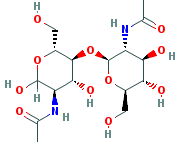|
N,N-DIACETYLCHITOBIOSE |
| Synonyms. N,N-Diacetylchitobiose; Bis(N-acetyl)chitobiose; Di-N-acetylchitobiose; 2-(Acetylamino)- 4O-( 2-(acetylamino)-2-deoxy-beta-D-glucopyranosyl)-2-deoxy-D-glucose; N,N'-Diacetylchitobioside; Chitobiose; |
|
|
| PRODUCT IDENTIFICATION | |
|
CAS RN |
35061-50-8 |
|
EINECS RN |
|
|
FORMULA |
C16H28N2O11 |
|
MOLE WEIGHT |
424.40 |
|
H.S CODE |
|
|
SMILES |
O=C[C@@H]([C@@H](O)[C@H](O[C@H]1[C@@H]([C@@H](O)[C@H](O) [C@ H](O1)CO)NC (=O)C)[C@H](O)CO) NC(=O)C |
|
CLASSIFICATION |
|
|
EXTRA NOTES |
Biochem/physiol Actions:In chitinolytic bacteria, such as Vibrio, Streptomyces and Serratia, N,N′-Diacetylchitobiose (GlcNAc2) is not only a major breakdown product of chitinase, but it is also the smallest substance that induces chitinase production. It can also be utilized as a carbon source by E. coli, which does not express chitinases, but is exposed to GlcNAc2 produced by intestinal chitinolytic bacteria. In most organisms, the uptake of GlcNAc2 occurs via the phosphoenolpyruvate:glycose phosphotransferase system (PTS). GlcNAc2 has also been used as a substrate or inhibitor to study the activity of glycolytic enzymes. sigmaaldrich |
|
|
| PHYSICAL AND CHEMICAL PROPERTIES | |
|
PHYSICAL STATE |
white to off-white crystalline powder |
|
MELTING POINT |
245 ~ 247 C |
|
BOILING POINT |
|
|
DENSITY |
|
|
SOLUBILITY IN WATER |
|
| SOLVENT SOLUBILITY |
|
|
VAPOR DENSITY |
|
|
log P(octanol-water) |
|
|
VAPOR PRESSURE |
|
|
AUTOIGNITION TEMP |
|
| pK |
|
|
REFRACTIVE INDEX |
|
|
FLASH POINT |
|
|
|
| STABILITY AND REACTIVITY | |
| STABILITY | Stable under normal conditions. |
|
INCOMPATIBLE MATERIALS |
Strong oxidizing agents. |
| POLYMERIZATION |
Has not been reported |
|
NFPA RATINGS |
Health: 1, Flammability: 1, Reactivity: 0 |
|
|
| EXTERNAL LINKS & GENERAL DESCRIPTION |
|
USA.gov - N,N-Diacetylchitobiose Google Scholar Search - N,N-Diacetylchitobiose PubChem Compound Summary - N,N-Diacetylchitobiose KEGG (Kyoto Encyclopedia of Genes and Genomes) - N,N-Diacetylchitobiose ChEBI (http://www.ebi.ac.uk/chebi/) - N,N-Diacetylchitobiose NCBI (http://www.ncbi.nlm.nih.gov/) - N,N-Diacetylchitobiose Material Safety Data Sheet - N,N-Diacetylchitobiose |
|
|
| SALES SPECIFICATION | |
|
APPEARANCE |
white to off-white crystalline powder |
|
ASSAY |
98% min |
|
MELTING POINT |
245 ~ 247 C |
|
LOSS ON DRYING |
1% max |
|
HEAVY METALS |
10ppm max |
|
|
| TRANSPORT & REGULATORY INFORMATION | |
|
UN NO. |
|
| HAZARD CLASS |
|
| PACKING GROUP | |
|
|
| SAFETY INFORMATION | |
|
HAZARD OVERVIEW |
GHS (Globally Harmonised System) Classification: Skin irritation. Eye irritation. Hazard statements: Causes skin irritation. Causes serious eye irritation. |
| SIGNAL WORD | Warning |
|
PICTOGRAMS |
|
|
HAZARD STATEMENTS |
H315-H319 |
|
P STATEMENTS |
P305 + P351 + P338 |
| EC DIRECTIVES |
|
| HAZARD CODES |
|
|
RISK PHRASES |
36/38 |
|
SAFETY PHRASES |
26-36 |
|
|
| PACKING |
|
Preserved in light-resistant and well-closed bottles |
|
|

